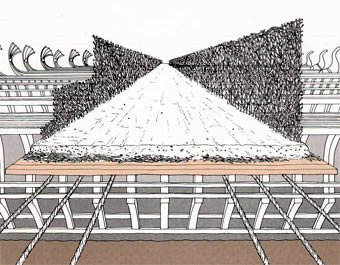Pontoon
Bridge - 480 BC

A
major obstacle in the path f the Persian King Xerxes' army was
the Hellespont, a waterway at the head of the Aegean that was
nearly a mile wide at its narrowest and separated Asia Minor
from Europe. Xeres bridged the gap with ships, not in a ferrying
operation but by constructing a unique pair of bridges with
hundreds of vessels ranged side by side.
The
120-foot-long ships were lashed together parallel to the banks
of the Hellespont. "Having joined the vessels." wrote
the Greek historian Herodotus, the bridgebuilders "moored
them with anchors of unusual size." in order to resist
the strong currents and the winds that blew through the Hellesport.
The Persians then strung cables of papyrus and flax across the
floating vessels from bank to bank, and windlasses on both beaches
winched the cables taut. Next, Herodotus reports, planks "were
laid side by side upon the tightened cables" and fastened
in place.
Xeres'
engineers, in short, built a combination suspension and pontoon
bridge. The cables took some of the weight and provided more
consistent stability than the separate vessels, and the ships
kept the lengthy, heavy cables from sagging into the water.
Atop
the planks of this combination bridge, soil was packed down
to make an earthen roadway for the cavalry and troops. Walls
made of matted branches (cut away in the drawing above to show
the ships) were built to concern the Hellespont so that Xeres'
horses would not panic.
Xeres
built two of these bridges, using 360 ships to cross a stretch
a mile and a quarter wide and 314 vessels at a narrower crossing.
So gigantic was his army that its horses trampled across the
two highways for a week.
From
The Ancient Mariners Time Life Books
|